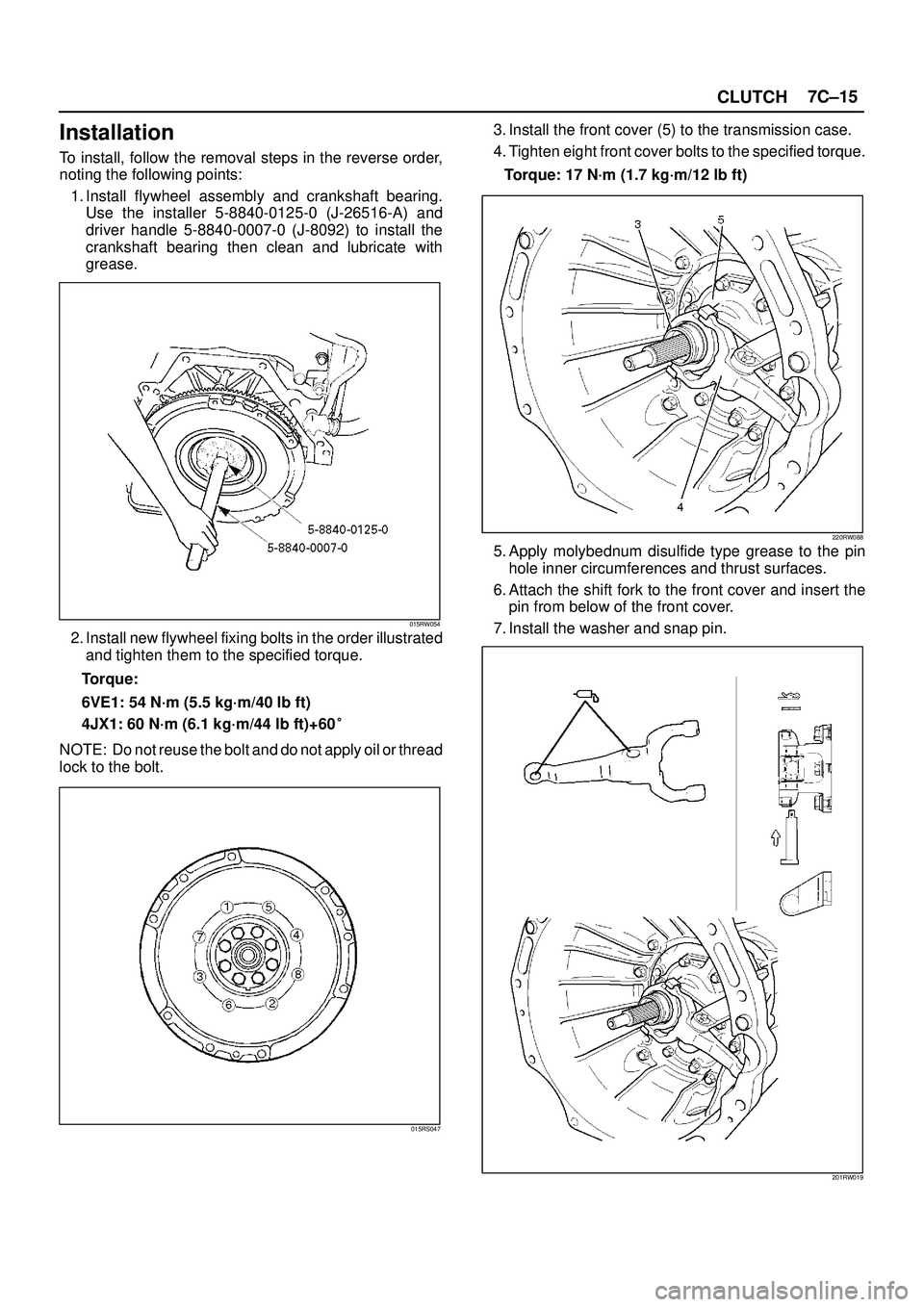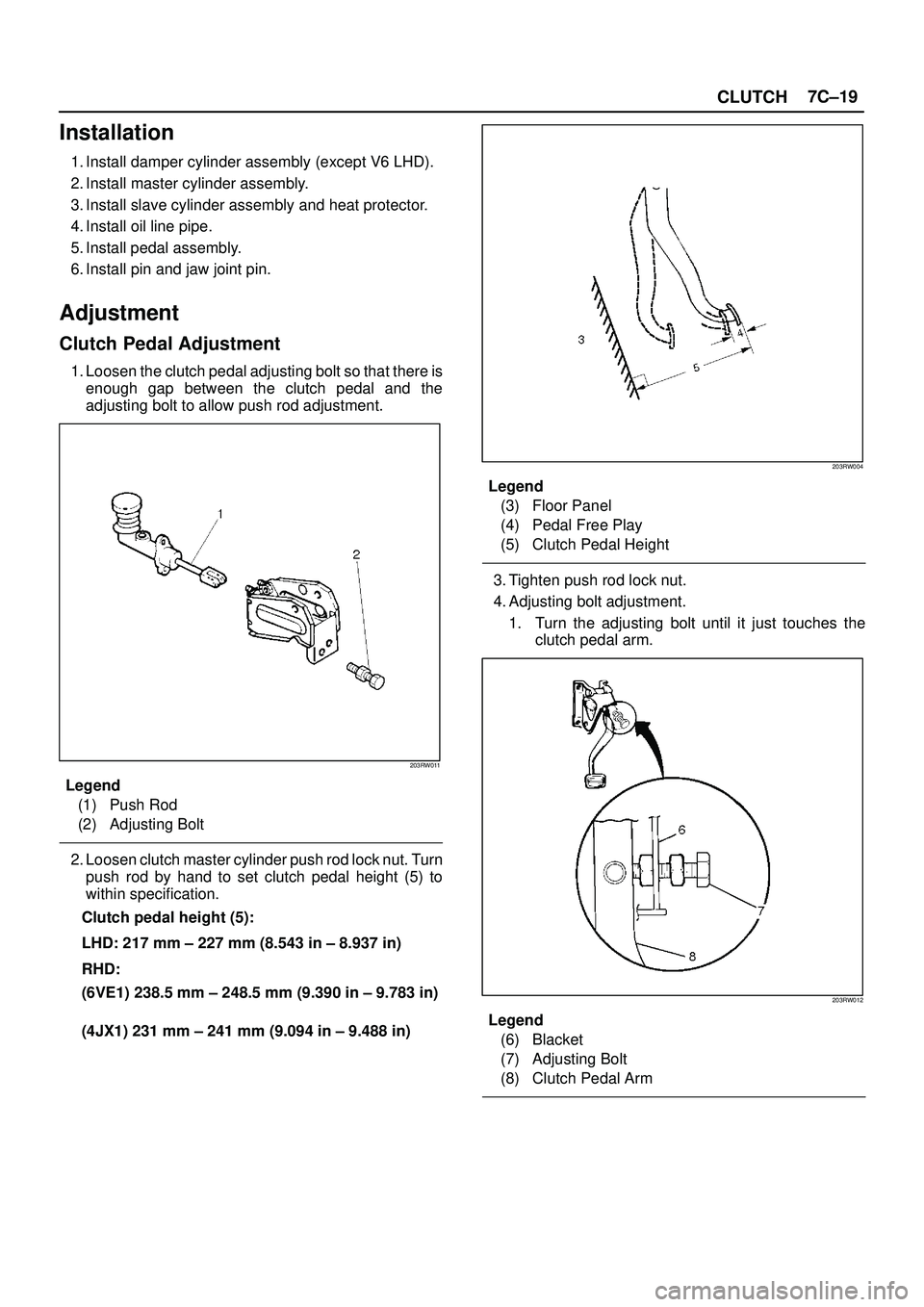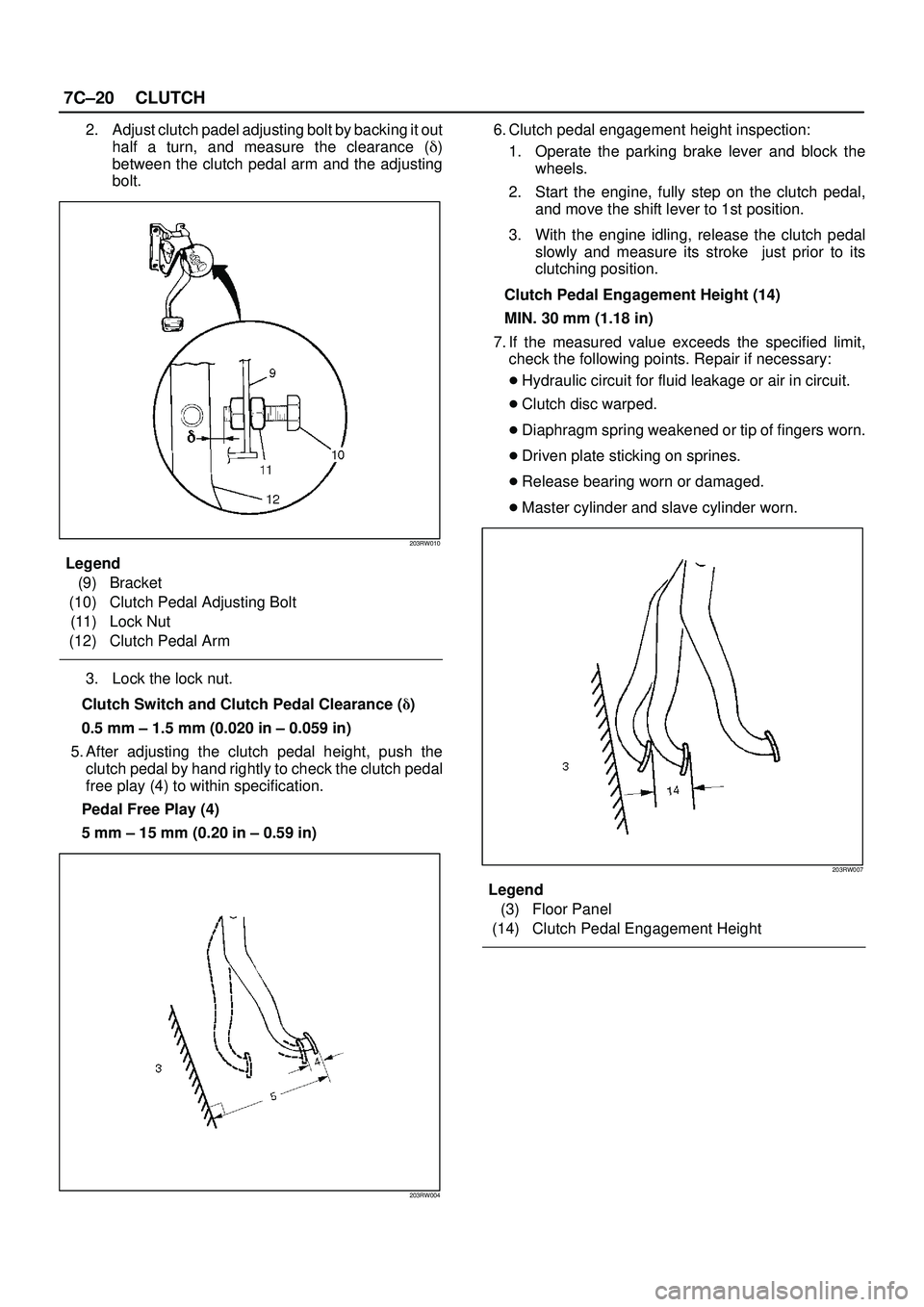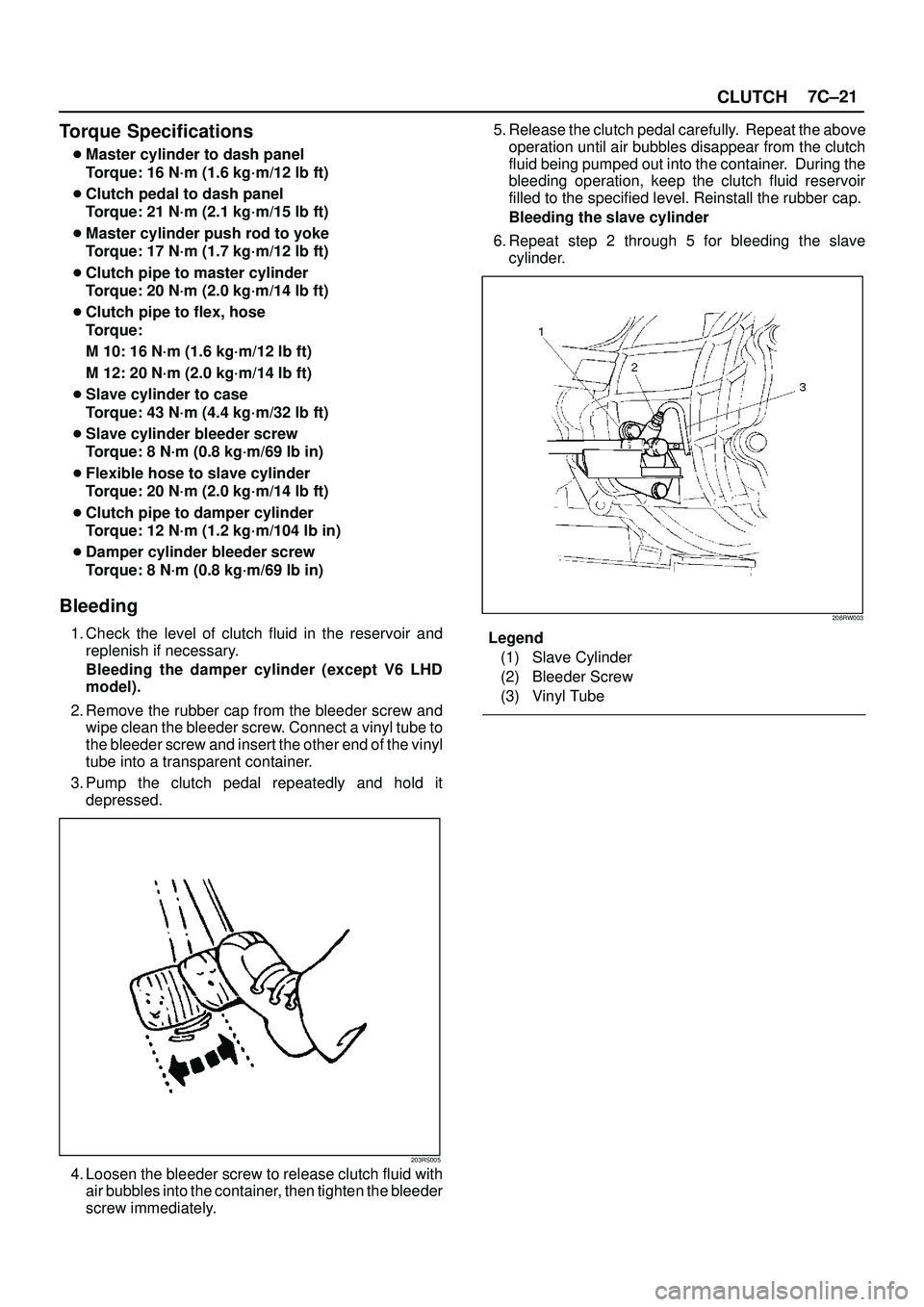Page 2523 of 3573
7C±14CLUTCH
Release Bearing
201RS011
1. Visually check the release bearing for excessive play,
noise and breakage.
2. If any of these conditions are discovered, the release
bearing must be replaced.
3. When replacing the release bearing, replace both the
wedge collar and wire ring at the same time.
201RW010
Legend
(1) Wire Ring
(2) Pressure Plate Assembly
(3) Wedge Collar
(4) T/M Side
(5) Release Bearing
(6) Engine Side
Wedge Collar
201RS013
1. Visually check the surfaces of the wedge collar
making contact with the release bearing for excessive
wear and damage.
2. Replace any exhibiting excessive wear or damage.
Shift Fork
201RS014
1. Visually check the surfaces of the shift fork making
contact with the release bearing for excessive wear
and damage.
2. Remove any minor stepping or abrasion from shift
fork with an oil stone.
3. Replace any exhibiting excessive wear or damage.
Page 2524 of 3573

CLUTCH7C±15
Installation
To install, follow the removal steps in the reverse order,
noting the following points:
1. Install flywheel assembly and crankshaft bearing.
Use the installer 5-8840-0125-0 (J-26516-A) and
driver handle 5-8840-0007-0 (J-8092) to install the
crankshaft bearing then clean and lubricate with
grease.
015RW054
2. Install new flywheel fixing bolts in the order illustrated
and tighten them to the specified torque.
Torque:
6VE1: 54 N´m (5.5 kg´m/40 lb ft)
4JX1: 60 N´m (6.1 kg´m/44 lb ft)+60�
NOTE: Do not reuse the bolt and do not apply oil or thread
lock to the bolt.
015RS047
3. Install the front cover (5) to the transmission case.
4. Tighten eight front cover bolts to the specified torque.
Torque: 17 N´m (1.7 kg´m/12 lb ft)
220RW088
5. Apply molybednum disulfide type grease to the pin
hole inner circumferences and thrust surfaces.
6. Attach the shift fork to the front cover and insert the
pin from below of the front cover.
7. Install the washer and snap pin.
201RW019
Page 2525 of 3573
7C±16CLUTCH
8. Apply molybdenum disulfide type grease to the areas
shown in illustration.
201RW012
9. Install the release bearing in the proper direction.
NOTE: Ensure release bearing is properly positioned
during installation, as shown in illustration.
201RW020
10. Install driven plate assembly. Use the pilot aligner
5-85253-001-0 (J-24547) to install the driven plate
assembly.
201RW027
11. Install pressure plate assembly and tighten the bolts
holding the pressure plate assembly in the order
shown in illustration.
Torque: 18 N´m (1.8 kg´m/13 lb ft)
201RS017
12. Remove the aligner.
NOTE: Do not strike the aligner with a hammer to remove
it.
13. Install transmission assembly.
Page 2526 of 3573
CLUTCH7C±17
Clutch Control
Clutch Control Parts
(6VE1 LHD)
203RW017
Legend
(1) Master Cylinder Assembly
(2) Pedal Assembly(3) Pin and Jaw Joint Pin
(4) Oil Line Pipe
(5) Slave Cylinder Assembly and Heat Protector
Page 2527 of 3573
7C±18CLUTCH
(Except 6VE1 LHD)
203RW009
Legend
(1) Master Cylinder Assembly
(2) Pedal Assembly
(3) Pin and Joint Pin (4) Oil Line Pipe
(5) Slave Cylinder Assembly and Heat Protector
(6) Damper Cylinder Assembly
Removal
1. Remove pin and jaw joint pin.
2. Remove pedal assembly.
3. Remove oil line pipe.
4. Remove slave cylinder assembly and heat protector.
5. Remove master cylinder assembly.
6. Remove damper cylinder assembly (except V6 LHD).
Inspection and Repair
Make necessary adjustments, repairs, and part
replacement if wear, damage or other problems are
discovered during inspection.
Page 2528 of 3573

CLUTCH7C±19
Installation
1. Install damper cylinder assembly (except V6 LHD).
2. Install master cylinder assembly.
3. Install slave cylinder assembly and heat protector.
4. Install oil line pipe.
5. Install pedal assembly.
6. Install pin and jaw joint pin.
Adjustment
Clutch Pedal Adjustment
1. Loosen the clutch pedal adjusting bolt so that there is
enough gap between the clutch pedal and the
adjusting bolt to allow push rod adjustment.
203RW011
Legend
(1) Push Rod
(2) Adjusting Bolt
2. Loosen clutch master cylinder push rod lock nut. Turn
push rod by hand to set clutch pedal height (5) to
within specification.
Clutch pedal height (5):
LHD: 217 mm ± 227 mm (8.543 in ± 8.937 in)
RHD:
(6VE1) 238.5 mm ± 248.5 mm (9.390 in ± 9.783 in)
(4JX1) 231 mm ± 241 mm (9.094 in ± 9.488 in)
203RW004
Legend
(3) Floor Panel
(4) Pedal Free Play
(5) Clutch Pedal Height
3. Tighten push rod lock nut.
4. Adjusting bolt adjustment.
1. Turn the adjusting bolt until it just touches the
clutch pedal arm.
203RW012
Legend
(6) Blacket
(7) Adjusting Bolt
(8) Clutch Pedal Arm
Page 2529 of 3573

7C±20CLUTCH
2. Adjust clutch padel adjusting bolt by backing it out
half a turn, and measure the clearance (�)
between the clutch pedal arm and the adjusting
bolt.
203RW010
Legend
(9) Bracket
(10) Clutch Pedal Adjusting Bolt
(11) Lock Nut
(12) Clutch Pedal Arm
3. Lock the lock nut.
Clutch Switch and Clutch Pedal Clearance (�)
0.5 mm ± 1.5 mm (0.020 in ± 0.059 in)
5. After adjusting the clutch pedal height, push the
clutch pedal by hand rightly to check the clutch pedal
free play (4) to within specification.
Pedal Free Play (4)
5 mm ± 15 mm (0.20 in ± 0.59 in)
203RW004
6. Clutch pedal engagement height inspection:
1. Operate the parking brake lever and block the
wheels.
2. Start the engine, fully step on the clutch pedal,
and move the shift lever to 1st position.
3. With the engine idling, release the clutch pedal
slowly and measure its stroke just prior to its
clutching position.
Clutch Pedal Engagement Height (14)
MIN. 30 mm (1.18 in)
7. If the measured value exceeds the specified limit,
check the following points. Repair if necessary:
�Hydraulic circuit for fluid leakage or air in circuit.
�Clutch disc warped.
�Diaphragm spring weakened or tip of fingers worn.
�Driven plate sticking on sprines.
�Release bearing worn or damaged.
�Master cylinder and slave cylinder worn.
203RW007
Legend
(3) Floor Panel
(14) Clutch Pedal Engagement Height
Page 2530 of 3573

CLUTCH7C±21
Torque Specifications
�Master cylinder to dash panel
Torque: 16 N´m (1.6 kg´m/12 lb ft)
�Clutch pedal to dash panel
Torque: 21 N´m (2.1 kg´m/15 lb ft)
�Master cylinder push rod to yoke
Torque: 17 N´m (1.7 kg´m/12 lb ft)
�Clutch pipe to master cylinder
Torque: 20 N´m (2.0 kg´m/14 lb ft)
�Clutch pipe to flex, hose
Torque:
M 10: 16 N´m (1.6 kg´m/12 lb ft)
M 12: 20 N´m (2.0 kg´m/14 lb ft)
�Slave cylinder to case
Torque: 43 N´m (4.4 kg´m/32 lb ft)
�Slave cylinder bleeder screw
Torque: 8 N´m (0.8 kg´m/69 lb in)
�Flexible hose to slave cylinder
Torque: 20 N´m (2.0 kg´m/14 lb ft)
�Clutch pipe to damper cylinder
Torque: 12 N´m (1.2 kg´m/104 lb in)
�Damper cylinder bleeder screw
Torque: 8 N´m (0.8 kg´m/69 lb in)
Bleeding
1. Check the level of clutch fluid in the reservoir and
replenish if necessary.
Bleeding the damper cylinder (except V6 LHD
model).
2. Remove the rubber cap from the bleeder screw and
wipe clean the bleeder screw. Connect a vinyl tube to
the bleeder screw and insert the other end of the vinyl
tube into a transparent container.
3. Pump the clutch pedal repeatedly and hold it
depressed.
203RS005
4. Loosen the bleeder screw to release clutch fluid with
air bubbles into the container, then tighten the bleeder
screw immediately.5. Release the clutch pedal carefully. Repeat the above
operation until air bubbles disappear from the clutch
fluid being pumped out into the container. During the
bleeding operation, keep the clutch fluid reservoir
filled to the specified level. Reinstall the rubber cap.
Bleeding the slave cylinder
6. Repeat step 2 through 5 for bleeding the slave
cylinder.
206RW003
Legend
(1) Slave Cylinder
(2) Bleeder Screw
(3) Vinyl Tube